Feed, treats and supplements for Pekin bantams.
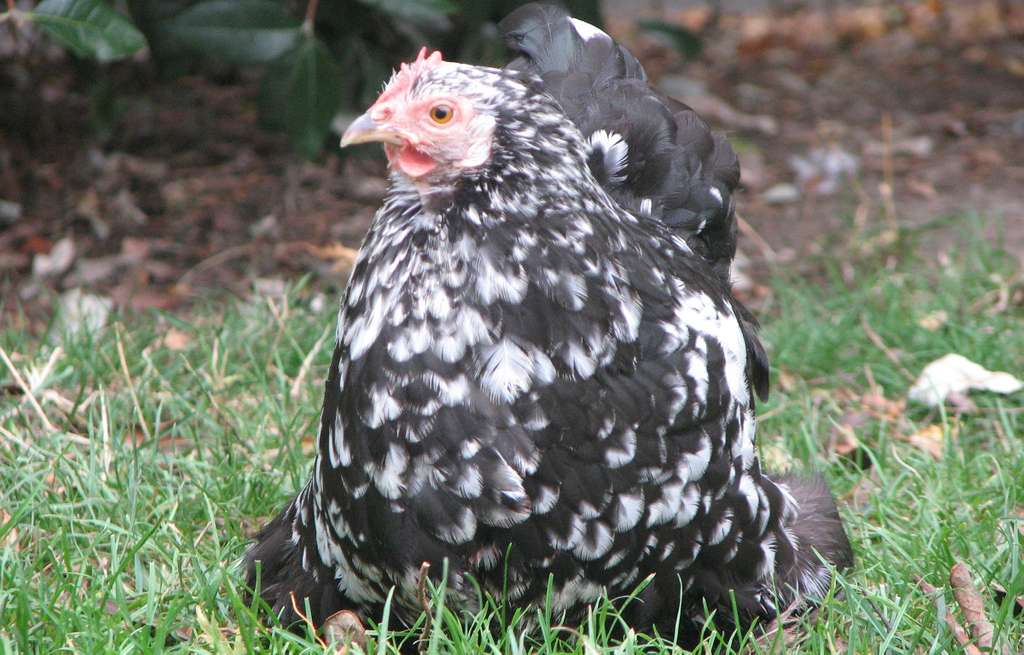
Feeding Pekins and bantams:
Poultry types and species all very regarding their feeding needs. However, there are basic principles which they all have in common. That is the way they gain and use various nutrients.
Pekin chickens require a liberal supply of quality pelleted feed along with green food and a selection of different grains on occasion. Treats should never be more than 5% of the total diet.
All chickens are omnivorous and will feed on insects, fruits, grain, seeds, flower petals, seed heads, plant matter, arthropods, reptiles, amphibians, and in gardens, bread and other scraps.
Below: Dried mash in a feeder. The smaller particle size suits bantams.
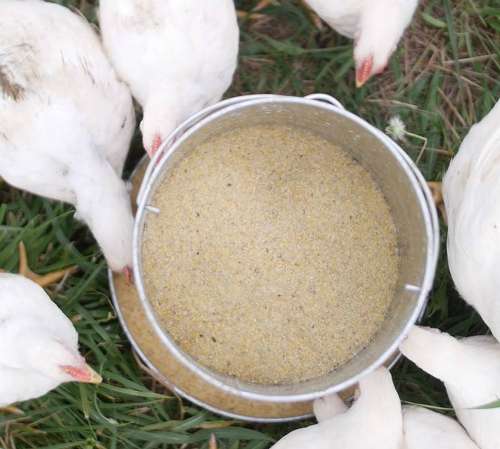
Poultry will exclusively feed on almost anything edible, animals or plants, these birds are often found to prey on even small mammals including mice, vole, and sometimes even small snakes. Barnyard chickens will snap flies from the air or pursue butterflies across the fields.
If birds free-range or have treat access, start by feeding them a complete feed in the morning before they go out exploring. Remember that scratch grains should to some extent be seen as treats and not take the place of a complete feed.
Chickens are natural foragers, so trying new foods is inevitable but chickens tend to avoid foods that are bad or harmful for them, but some are healthier than others.
When it comes to foraging, there is a lengthy list of plants that chickens love as treats. Dark leafy greens can result in darker, richer yolks. Lettuce, kale, turnip greens and chard are great greens options.
Watermelon, strawberries and blueberries make healthy snacks for chickens when fed in moderation. For a full list of what I use as treats see below.
Feeding Pekin bantam chicks:
Pekin chicks are hardy and will thrive on ordinary chick crumb from the earliest stages. Avoid feeding mash during the growing period since it very often results in "sour - crop".
Below: Chicks eating crumb.
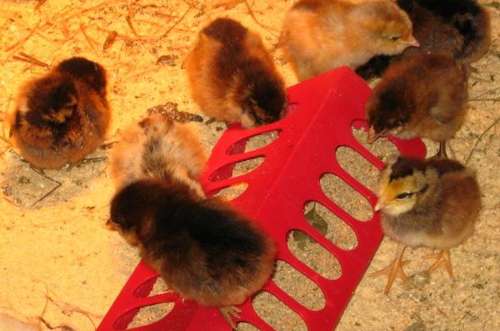
I provide dry feed for the first day the chicks are out of the nest and the chicks receive as much as they can eat.
I would say it as a mistake to allow too much time to elapse before the first feed is given. When feed is made available from the beginning it will be found that the chicks eat a little at a time, whereas hungry chicks in my experience stuff themselves and overload their crops.
Finely cut spinach fed is provided for the youngsters to pick at.
After six weeks I feed mixed and sprouted grains to the the extent of of one-quarter of the total ration, gradually switching to grower as the chicks are weaned from the original chick mixture.
Below: Chickens eating sprouted grains.
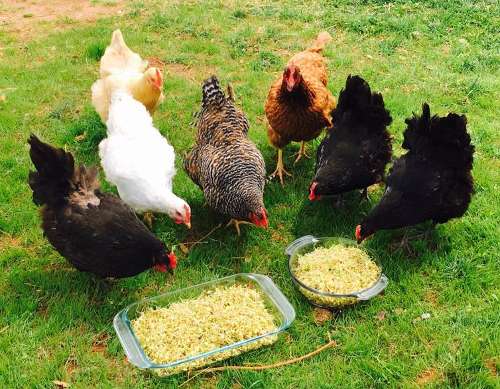
The provision of plenty of food hastens maturity and early laying, which of course checks growth.
HOW OFTEN SHOULD YOU FEED PEKIN BANTAMS?
You should feed your Pekin bantams every day with a quality pelleted feed or suitable mash. This should always be available.
Add whatever treats you wish on top but make the feed at least 90% of the diet.
Importance of weight for the Pekin:
Never waste the time and the entrance fee by showing a Pekin that is overweight. Success is much more likely to be ensured by keeping below the limit. My best Pekin hen I have ever bred, weighs 18oz and my heaviest male bird weighs 23oz. The abundant plumage of these bantams make them appear heavier.
Too much whole wheat or corn in the diet can produce overweight chickens.
What is the best feed for Pekin chickens?
I regard the provision of ample good quality and diverse food and cleanliness as the chief factors contributing to my success with Pekin bantams. You can't go wrong if your birds have a steady supply of quality pellets to eat.
Below: Pekin bantams free ranging on grass.
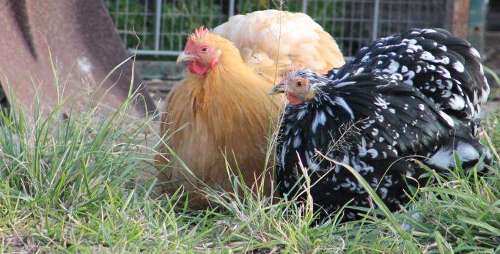
My birds get a mix that contains 50% pelleted feed mixed with a variety of seeds and grains.
Treats for Pekin chickens:
There are hundreds of things you can give chickens as treats but not all are good for them. These are my favourite things to treat my flock with.
- Earthworms.
- Corn on the cob.
- Fresh or frozen cooked peas.
- Sunflower or safflower hearts.
- Vegetables like Lettuce, beets, broccoli, carrots, kale, Swiss chard, squash, pumpkins and cucumbers.
- Herbs like mint, oregano, parsley, cilantro, thyme and basil.
- Dandelions are good plants for chickens as all parts are edible.
Below: A few chickens having a treat.
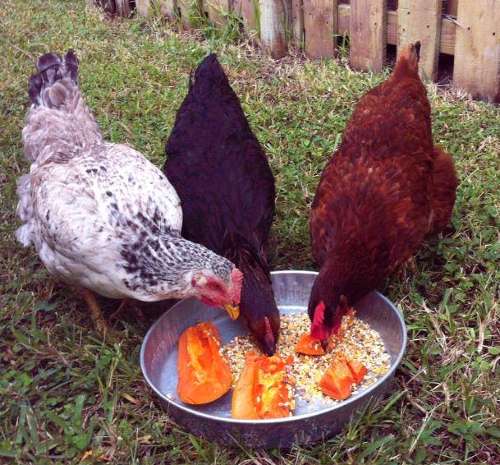
Supplements for Pekin bantams:
Other than mixed grit and oyster shell, supplements for chickens are not for everyday use. If your are finding you need to supplement all the time then you need a better quality feed or have a problem that needs looking in to.
The links below are affiliate link, If you buy the product we get a small commission at no cost to you.
Grit: Is a necessity for chickens whether or not they free-range. In the wild, chickens with pick up small stones that collect in the gizzard. These small pieces of gravel act like teeth and help to break the chicken’s food into smaller pieces. Grit can be offered in a separate container from their food or mixed in with the calcium or ration for them to help themselves to.
Buy Scratch and Peck Feeds - Cluckin' Good Layer Grit Supplement for Chickens and Ducks - 7-lbs on Amazon.
Calcium: Calcium is essential for proper eggshell formation. Most layer feeds have a calcium additive of some sort and should be enough for your chickens.
If a hen isn’t getting enough calcium she will start to pull calcium from her bones in order to produce eggshells. If you notice soft shell eggs (eggs that have a rubbery shell rather than a hard one) it’s time to offer a calcium supplement.
You can feed dried crushed eggshells back to your hens, or you can purchase an oyster shell supplement from most feed stores that carry chicken products. It is often included as crushed oyster shell mixed in with the poultry grit.
Seaweed flakes: Contain Iodine and salts amongst other things that are good for poultry in small doses. Dosage of seaweed flakes for poultry is 1 teaspoon per kilogram of feed.
Dried Brewers yeast: Normally a feed additive for horses, I have found small amount are excellent for chickens. Yeast provides many trace minerals such as iron, phosphorus, and potassium. Yeasts are high in B-complex vitamins. Nutritional and food yeasts are 40-55% protein and contain all the essential amino acids for complete protein utilisation. Dosage is between 1 teaspoon and 1 tablespoon per kilogram of feed.
Brewers Yeast (5 lbs) on Amazon.
Electrolytes: Electrolytes added to the water will help replenish lost minerals after illness, moulting or stressful situations. buy a proprietary mix and follow the manufactures instructions.
Probiotics: Probiotics help with your chicken’s immune systems and digestive health. They can be added to the drinking water or sprinkled over your flock’s food. Probiotic powders for feeds or liquids for adding to the water can be purchased at most feed stores.
Diatomaceous earth: I personally use diatomaceous earth (DE) with my flock. It is an effective supplement and works well for external parasites. Diatomaceous earth is made from the fossilised remains of tiny, aquatic organisms called diatoms.
The diatoms are crushed into a fine powder and can be used as a supplement in this form. They contain natural silica which is essential for joint and cartilage formation. It’s also believed that DE can help rid the system of parasites by making small cuts on the exoskeleton of the parasite, which kills it.
Only use food grade DE and wear a respiratory mask when using it. Dosage is one tablespoon per kilogram of feed and 100 grams per bird in the dust bath topped up occasionally.
Molasses: Molasses is a great source of iron and other minerals. It also helps other supplements like DE, probiotics, and garlic powder to stick to the feed which helps with intake. Simply add a 1/4 cup to a gallon feed and mix well.
Protein: During the moulting season chickens benefit from extra protein in their diet. Earthworms or scrambled eggs make great high protein treat. Don't give protein supplements to often as they can lead to kidney problems and shell less eggs.
Apple Cider Vinegar: Apple cider vinegar has some health benefits to offer. It is supposed to help thin mucus if your chickens are suffering from respiratory issues. It helps with digestion, and it can alkalise the body making internal parasites uncomfortable.
Not all apple cider vinegar is the same. The best is the kind with the “Mother” still intact. The mother is the live bacteria in the vinegar from which most of the health benefits come. ACV can be added 10 to 25 ml to a gallon of fresh water. This should be rotated with plain water every other day or so.
What is in chickens feed?
Poultry has a simple digestive tract and eat foods such as cereals, seeds and insects or small mammals. Their food is composed of a number of nutrients that are essential to the bird’s health, maintenance and production of eggs and feathers.
The six main nutrients are protein, carbohydrates, fats, vitamins, minerals and water:
Protein is needed for growth, replacement of old cells and production of eggs and feathers. Sources of protein include meat-meal and fish-meal, oil-seeds such as soybean meal and sunflower seed meal, and other high-protein foods such as peas and lupins.
Carbohydrates are sources of energy needed for normal body maintenance and activity. They are provided by the cereals such as wheat, barley, maize, oats and sorghum.
Fats are also sources of energy, and they are needed for body maintenance and storage. They are very high in energy, and therefore added fats are usually used only in high-energy broiler (meat chicken) feeds.
Vitamins are needed only in very small amounts but they are essential to chemical processes taking place in the body. Examples are vitamin A, which is required for normal growth, and vitamin D, which is needed to prevent rickets.
Minerals are needed also only in small amounts. Examples are calcium and phosphorus, in the form of limestone or bone flour, for eggshell formation.
Water is an essential nutrient needed for all chemical processes in the body, and must always be available.
Crude Protein:
Dietary protein is important for animal growth. Crude protein is a measurement based on the nitrogen content of ingredients. However, not all protein is the same. The components (amino acids) that make up crude protein can differ a great deal in type and concentration from one source to the next. Therefore the quality of protein also varies.
There are essential and non-essential amino acids. Essential amino acids must be provided in the diets, while non-essential amino acids can be produced by the animal itself if necessary. The dietary balance of amino acids is also very important. An animal will not perform well if the ratio of one or more amino acids to the others is not appropriate.
Protein can be found in most feed stuffs, but concentrated protein supplements are often used in diets to meet amino acid requirements. Cereal grains alone do not provide enough of the essential amino acids or a balanced profile.
Typical sources of concentrated protein are oil-seed meals (such as soybean meal), meat meal and fish meal. Canola meal and legumes (peas, lentils) can be used in limited quantities.
Carbohydrates:
Carbs in poultry feed usually comes from grains and provides the energy in the diet.
Fats:
Very little fat is added to poultry feeds, various meals are used after being pressed for oil so fats in pelleted chicken feed are normally residual.
Vitamins:
The word Vitamin is a contraction and joining of the words vital amines.
These are required by all animals in order to maintain health and maximise production. Which ones are essential, and the concentrations which are required varies amongst animal species. Vitamins are organic compounds which are required in very small amounts. They are important for most physiological processes, including normal growth, feathering and leg development.
Deficiencies of various vitamins may cause problems such as: skin lesions, nervous disorders, muscle problems, reduced egg production, reduced growth, and improper chick development in eggs from breeding birds. The severity of any of these problems will depend on which vitamin is inadequate, and how deficient the diet is.
Minerals:
Minerals are often classified as macro or trace minerals in reference to the concentrations required. Macro-minerals such as calcium and phosphorus are generally required in larger quantities than trace minerals (iron, copper, iodine etc.). In some cases, calcium and phosphorus for example, the ratio of one to the other is also important. Minerals are important for structural components (such as bones) and/or physiological processes.
Deficiencies can lead to similar problems as those caused by inadequate dietary vitamins. Essential vitamins and minerals are not always found in sufficient quantities and/or available forms in the feed stuffs used for poultry. They are therefore supplemented in diets by using vitamin and mineral premixes. Premixes are formulated specifically for each species, for example, laying birds require a substantially higher amount of calcium and phosphorus than other birds.
Lots of different makes of pellets or mash are available and are a very convenient and mess free way to feed your stock. Pellets are used by most fanciers and are usually fed dry.These dried pellets and mashes are made up by various manufacturers and should be available from agricultural/corn merchants. Most pet shops would be happy to supply you, but in some cases you may need to order this. Pellets and mash are usually sold in 20/25 kilo sacks; if you have a very small number of birds you should be able to buy smaller amounts loose.
Mash can be wet or dry. Wet mesh has the advantage over dry in that less is wasted by the bird flicking out of the feeders, but you must make sure that it is eaten up within the same day, or it will go sour and be wasted. Your feeders will need washing regularly to remove any wet mash left sticking to them. Dry mash doesn't give you this problem but you may find that unless your feeders have a lip to prevent the bird flicking the mash about, the birds waste more than they actually consume.
It is also possible to feed the birds on grain along with your pellets, or instead of them altogether. Bear in mind that if you feed a large proportion of something else with a balanced diet you may be unbalancing it! Wheat may be fed to Pekins along with pellets, either mixed together- about half and half- or as a separate feed, often given before the birds roost.
It can be bought cheaply, especially if you can find a tame farmer! Maize tends to make birds fat if they are given too much; this is bad because it makes them unhealthy and less fertile, but in small quantities or as an occasional food, it will keep their legs and beaks a lovely shade of yellow- ideal for showing. Chopped oats is another well used food; other grains are available, but are less balanced that, say, wheat.
Colombian Pekin having her tea.
Grit:
There are two main ways in which the birds will use grit. Small stones are used by the birds to grind down any hard feed such as corn. The birds must be allowed this if they are fed corn in any quantity, otherwise they will not be able to digest it properly.
The grit is held in a muscular organ called the gizzard, and here it physically grinds down the corn. The birds have developed this organ to compensate for the fact that they swallow food whole and are unable to chew.
The other use for grit is to extract calcium for growth and maintenance, but especially for the production of egg shells. Not all grits will yield calcium, but 'oyster shell', which is a mixture of crushed shells, can be bought especially for this purpose. You can also buy mixed grit containing both types.
Birds fed solely on mash/pellets do not need grit, as calcium is provided in the food and they can digest it without grinding; but you should provide it anyway as birds have a natural instinct to swallow small stones. Birds allowed to roam outside may be able to select their own girt from the ground. Grit should be always available ad lib from cups or hoppers.
A complete guide to both soluble and insoluble grit in a chickens diet.
Water:
Clean water must available at all times, When the birds are laying they will drink larger quantities. Bowls on the floor tend to get soiled easily, but there are many different fountains or drinkers available. I try to change the water in my drinking fountains every day, even if they are still half full.
Water is, the most important component of the bird’s body, and required for its life and productivity. A bird can lose 50% of its protein and can also lose 40% of its body weight and still survive.
However loss of body fluids up to 20% will cause death. The water content of the body of chick is 85% at the first week of life and by adult age, 55% of the body weight consists of water. Water makes up to 65% of the weight of an egg i.e. approximately 35 gms. For this reason a supply of good water is essential for any poultry operation. Moreover water serves many functions in the chicken some of which are:
It is the basic component of blood and lymph and makes up a high percentage of the body weight. It helps to cool the bird by evaporation through its lungs and air sacs.
Water is necessary for transport of nutrients in the body and aids in certain digestive processes.
It is the medium for a large number of chemical and metabolic reactions in the body.
Eyes and ears are lubricated by which reception of sound and light is improved and becomes well defined.
What should you not feed to chickens?
The rules of what not to feed chickens are:
- Never feed anything that is spoiled or mouldy. Moulds can produce toxins which can be fatal.
- Never feed them a single food exclusively, even birds on pellets should get greenery and the odd treat.
- Never feed types of food that are dominated by a single nutrient. Any feed-stuffs that are all fat, all carbohydrate, like bread, and all protein feeds are bad.
- Avoid salty and sugary foods.
- Never over-treat.
- Just because a chicken will eat something does not mean it is good for it.
Here is a full list of what chickens can and cannot eat.
What should chickens not eat
Rye grain should not be fed to young birds, as they cannot properly digest it and do very poorly. Rye can be included into laying hen diets up to 5% of the diet, because adult birds are better capable of digesting this grain.
Barley and oats contain a carbohydrate, b-glucan, which interferes with digestion and nutrient availability in young birds. These grains can be fed in small quantities to mature birds, but results are better if the enzyme, b-glucanase, is included in the diet. If the amount of barley in the diets is increased gradually as the birds get older, b-glucanase may not be needed.
Avoid treats that may cause an off flavour in eggs, garlic and onions are the two most common culprits that may impact egg flavour.
A few other foods should be avoided because they contain toxins that can make birds ill or even be fatal. Avocado pits and skins are toxic to chickens as they contain a toxin called persin.
Under cooked or dried beans can be harmful because they contain a compound known as haemagglutinin, which can inhibit digestion of everything the bird eats.
Rhubarb contains anthraquinones, which can have a laxative effect. Rhubarb damaged by the severe cold can also contain a high concentration of oxalic acid, which can be fatal to chickens.
Mouldy, rotten foods and very salty foods can result in excessively wet faeces and may be toxic.
Conclusion:
Chickens require 40 or so nutrients at the correct levels, and complete feeds are formulated to meet these demands. Choose one complete starter then grower feed for day 1 through week 18 and one complete layer feed for laying hens. To prevent nutrient dilution, provide a complete feed for at least 90 percent of the bird’s diet.
Corns and grains: Most cereals like wheat, barley, oats, and maize or corn, are satisfactory for feeding poultry species but should never make up the whole diet. A mixture will help to ensure a good nutrient balance.
A few small treats are all they should have each day.
